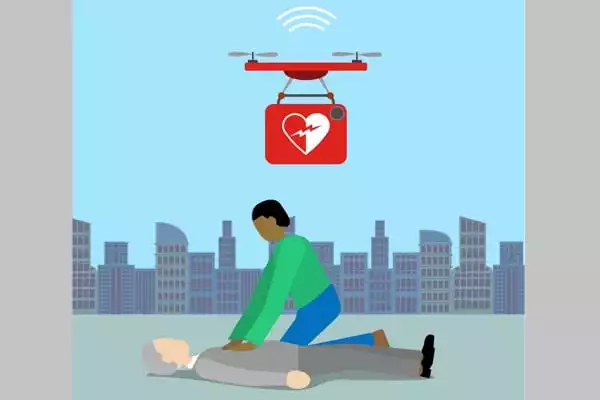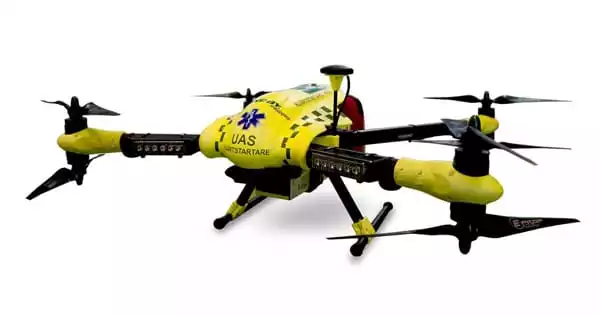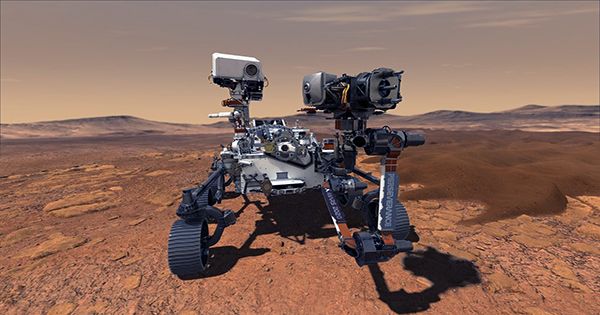Drones could deliver defibrillators to victims of cardiac arrest faster than ambulances. The world’s first feasibility study has discovered that drones can be used to deliver life-saving defibrillators to people in the community who are experiencing suspected cardiac arrest. The findings were presented at the ESC Congress in 2021 and published in the European Heart Journal.
“Drones delivered an automated external defibrillator (AED) just outside the door of residential homes, where most cardiac arrests occur, as well as during the first minutes of a cardiac arrest,” study author Dr. Sofia Schierbeck of Karolinska University Hospital in Stockholm, Sweden, explained. “It took nearly two minutes for a drone to arrive before the ambulance. As drone technology advances, the number of patients and time benefits should increase.”
Cardiac arrest is a potentially fatal condition in which the heart suddenly stops beating. Without cardiopulmonary resuscitation and an electric shock from an AED, it is fatal. Every minute spent without treatment reduces one’s chances of survival. It is estimated that cardiac arrest kills one out of every five people in developed countries. Survival has not improved over time, and the mortality rate is 90%.
A feasibility study has found that drones can be used to deliver life-saving defibrillators to people with suspected cardiac arrest in the community.
According to Dr. Schierbeck: “Response times for emergency medical services are increasing, and most people do not have an AED at home. We believe that novel methods of administering AEDs are required to improve the chances of survival in these patients. As a result, we conducted the first-ever study to investigate the feasibility of drone delivery of AEDs to patients experiencing suspected cardiac arrest outside of the hospital.”
A new study finds that drones could deliver automated defibrillators to patients whose hearts stopped in Sweden, arriving on time and ahead of ambulances in most cases. When a person suffers from sudden cardiac arrest, their hearts stop suddenly, and every minute it takes to respond counts.
The research was carried out in the Gothenburg metropolitan area in western Sweden, within the controlled airspace of an airport. When a suspected cardiac arrest occurs outside of a hospital, the usual procedure is for a witness to call the emergency number (112 in Sweden), and the dispatch center sends an alarm to the ambulances, which then drive as quickly as possible to the scene.

In this study, three drones with a 5 km radius flight range were set up in three different locations as a supplement. When a suspected cardiac arrest occurred in one of these three areas, the dispatch center notified the drone pilots at the drone control center. The drone pilot then contacted the air traffic control tower, and if the flight was approved, the drone was launched. The automated drone system was monitored by the drone pilot, and when it arrived at the scene, it descended to 30 m altitude before slowly winching down an AED. The victim’s bystander then retrieved the AED, which was beeping to attract attention.
14 cases of cardiac arrest qualified for inclusion from June to September 2020. In 12 of these, a drone took off. In 11 (92 percent) of these cases, an AED was successfully delivered on-site. The average flight distance was 3.1 kilometers, and the drones arrived at a distance of 9 meters from the victim. In 64% of cases, the drone arrived before the ambulance, saving time of 01:52 minutes.
Due to factors such as rain, high winds, high-rise buildings, and no-fly zones, 39 cases were deemed ineligible for inclusion in the study.
According to Dr. Schierbeck: “In contrast to previous simulation studies6,7, this was the first study to deploy drones equipped with AEDs in real-world emergencies. We created a system that uses AED-drone systems in remotely monitored hangars and is fully integrated with the emergency medical service, dispatch center, and aviation control. Our research shows that it is not only possible but also faster than an ambulance. This is the first proof of concept for the use of drones in emergency medicine anywhere in the world.”
She pointed out that one limitation of the drones used in the study was that they couldn’t fly in rain or strong winds (greater than 8 m/s). According to Dr. Schierbeck: “Drones should be able to fly in moderate rain and darkness by 2022. Longer battery life could increase the flight range and number of people covered by a single drone.”
Dr. Schierbeck concluded, saying: “AED delivery by drone could become commonplace in the coming years. It may also be expanded to other medical scenarios in the near future, such as the administration of epinephrine to patients suffering from anaphylactic shock or the administration of glucose to diabetic patients suffering from low blood sugar.”
















